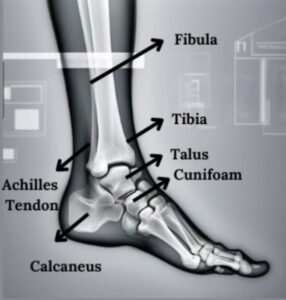Overview
Introduction
Any irritation, pain, aches, soreness, and tenderness in the ankle joint. The ankle consists of several bones. That’s why they are complex. The bones that make up the ankle joint are
Bone of Ankle joint
- Tibia, Talus, Fibula
 Nerves
Nerves- Tendons
- Muscles
- Blood vessels
- Ligament
In ankle injury, the cause depends on the condition. The most common are arthritis, Joint inflammation, Joint pain, Normal stress, and stretch. The patient feels pain tenderness swelling and inflammation around the ankle joint that causes the patient to be unable to walk
Ankle injury is controlled with pain-relieving medication, ice massage, and bed rest. The doctor handles arthralgia and ankle rupture in the event of an injury. In severe injuries like fractures, medications do not relieve pain, prompting the need for surgical intervention.
Consult with a doctor if you feel ankle injury continuously and it gets more intense with time.
Common Causes:
Common Causes of Ankle pain
- Traumatic Injuries: Ankle sprains, fractures, and dislocations cause ankle injuries. The lateral ligament complex, which is particularly susceptible to injury consists of the anterior talofibular ligament (ATFL), calcaneofibular ligament (CFL), and posterior talofibular ligament (PTFL).
- Degenerative Conditions: Osteoarthritis (OA), rheumatoid arthritis (RA), and post-traumatic arthritis cause ankle injuries. OA destroys cartilage, leads to subchondral bone sclerosis, and promotes osteophyte formation.
- Systemic Diseases: Gout, pseudo gout, and systemic lupus erythematosus (SLE) caused ankle injuries. Gout damages the metatarsophalangeal joint and generally induces crystal-related arthritis, but it can also affect the ankle joint.
- Overuse Injuries: Achilles tendinitis and peroneal tendinitis Inflammation and destruction of the Achilles tendon cause Achilles tendinitis.
- Sural nerve entrapment.
- Sinus Tarsi Syndrome.
Pain without an injury
- Poor Foot Mechanics: Abnormalities in foot mechanics. Overpronation can result from flat feet, while supination can result from high arches.
- Muscle Imbalances: weak peroneal or tight calf muscles, can cause ankle pain.
- Neurological Disorders: peripheral neuropathy or radiculopathy.
- Medical condition: DM can also cause .
Care and Treatment:
Relieving Ankle Pain
- Rest, Ice, Compression, and Elevation (RICE): RICE is the initial treatment. The symptoms can be alleviated by resting , applying ice to reduce pain and inflammation, compressing with an elastic bandage, and elevating the ankle above the level of the heart.
- Physical Therapy: improve ankle mobility, strength, and flexibility. A physical therapist can also offer advice on proper ankle mechanics and foot care.
- Medications: Ibuprofen and acetaminophen are over-the-counter pain relievers that can reduce pain and inflammation.
- Bracing and Support: Wearing ankle braces or orthotics can help reduce ankle pain and stabilize the joint.
- Joint aspiration
- Ankle Surgery
Prevent in the Ankle joint
It requires a proactive approach that incorporates the following strategies:
- A good pair of shoes that fit properly and provide support
- stretching and warming up before exercise or physical activity.
- Strengthening the muscles surrounding the ankle joint can enhance ankle stability and reduce the risk of ankle injury.
- Maintaining a healthy weight can enhance reduce the risk of injury by reducing stress on the ankle joint.
When To Seek Medical Attention
Serious in the Ankle pain
It requires immediate medical attention. Signs of serious include:
- Severe pain that does not respond to pain medication.
- Difficulty in walking and bearing weight on the affected side.
- The ankle joint is deformed or aligned abnormally.
- Instability or the feeling of giving way.
- Coldness or paleness in the affected ankle.
- Increasing pain with time.
Additional Question
Pain on the side of the ankle
Pain on the ankle side can be caused by a variety of factors, including:
- Inflammation and degeneration of the peroneal tendons.
- Ankle sprains can cause pain on the ankle side
- Abnormalities in foot mechanics, such as flat feet or high arches, can cause pain on the ankle side.
